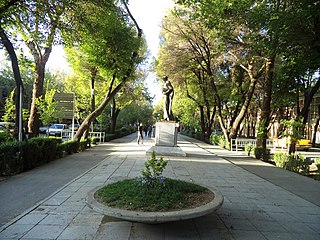
Isfahan or Esfahan/Espahan is a major city in the Central District of Isfahan County, Isfahan province, Iran. It is the capital of the province, the county, and the district. It is located 440 kilometres south of Tehran. The city has a population of approximately 2,220,000, making it the third-most populous city in Iran, after Tehran and Mashhad, and the second-largest metropolitan area.

Tabriz is a city in the Central District of Tabriz County, in the East Azerbaijan province of northwestern Iran. It serves as capital of the province, the county, and the district. It is the sixth-most-populous city in Iran.

A bazaar or souk is a marketplace consisting of multiple small stalls or shops, especially in the Middle East, the Balkans, Central Asia, North Africa and South Asia. They are traditionally located in vaulted or covered streets that have doors on each end and served as a city's central marketplace.

A caravanserai was a roadside inn where travelers (caravaners) could rest and recover from the day's journey. Caravanserais supported the flow of commerce, information, and people across the network of trade routes covering Asia, North Africa and Southeast Europe, most notably the Silk Road. Often located along rural roads in the countryside, urban versions of caravanserais were also historically common in cities throughout the Islamic world, and were often called other names such as khan, wikala, or funduq.

Azerbaijan or Azarbaijan, also known as Iranian Azerbaijan, is a historical region in northwestern Iran that borders Iraq and Turkey to the west and Armenia, Azerbaijan, and the Azerbaijani exclave of the Nakhchivan Autonomous Republic to the north.

The Bazaar of Tabriz is a historical market situated in the city center of Tabriz, Iran. It is one of the oldest bazaars in the Middle East and the largest covered bazaar in the world. It is one of Iran's UNESCO World Heritage Sites.

Chahar Bagh Boulevard is a historical avenue in Isfahan constructed in the Safavid era of Iran. This historic street is very similar to the Champs-Élysées in Paris, which some visitors called the Champs-Élysées of Isfahan.
Iranian Armenians, also known as Persian Armenians, are Iranians of Armenian ethnicity who may speak Armenian as their first language. Estimates of their number in Iran range from 70,000 to 500,000. Areas with a high concentration of them include Tabriz, Tehran, Salmas and New Julfa, Isfahan.

Vakil Bazaar is a bazaar of Shiraz, Iran, located in the center of the city.

A marketplace, market place, or just market, is a location where people regularly gather for the purchase and sale of provisions, livestock, and other goods. In different parts of the world, a marketplace may be described as a souk, bazaar, a fixed mercado (Spanish), itinerant tianguis (Mexico), or palengke (Philippines). Some markets operate daily and are said to be permanent markets while others are held once a week or on less frequent specified days such as festival days and are said to be periodic markets. The form that a market adopts depends on its locality's population, culture, ambient, and geographic conditions. The term market covers many types of trading, such as market squares, market halls, food halls, and their different varieties. Thus marketplaces can be both outdoors and indoors, and in the modern world, online marketplaces.

The Grand Bazaar is a market located in Isfahan, Iran, also known as the Qeysarriyeh Bazaar, Qeysarie bazaar or Soltani bazaar.

The 2018 protests in Iran were a series mass protests and a popular uprising in June 2018 calling for better economic justice in Iran, the biggest wave of anti-government demonstrations since the 2017-2018 Iranian protests.






















